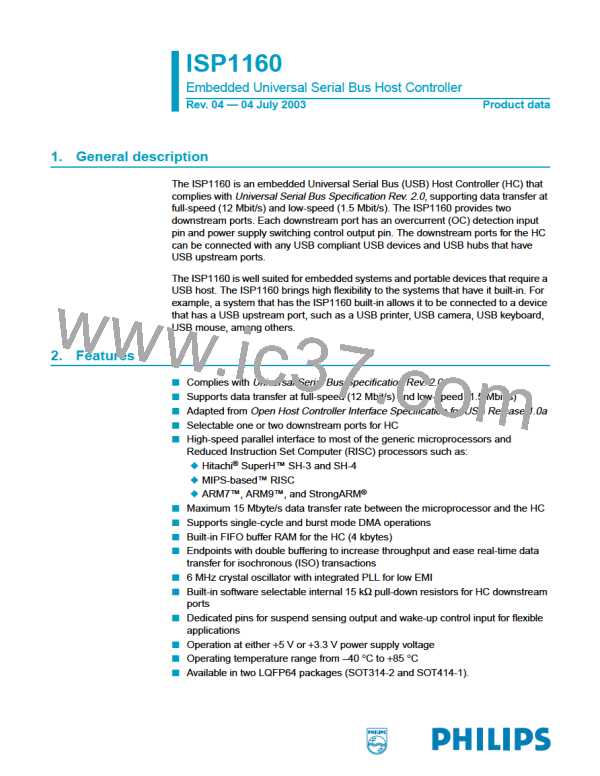ISP1160
Embedded USB Host Controller
Philips Semiconductors
Reset
Exit
no
HC state =
USBOperational
yes
Need
USB traffic?
Prepare PTD data in
µP system RAM
Transfer PTD data into
HC FIFO buffer RAM
Initialize
HC
HC informs HCD of
USB traffic results
HC performs USB transactions
via USB bus I/F
HC interprets
PTD data
Entry
MGT948
Fig 15. ISP1160 HC USB transaction loop.
Description of Figure 15:
1. Reset
This includes hardware reset by pin RESET_N and software reset by the
HcSoftwareReset command (A9H). The reset function will clear all the HC’s
internal control registers to their reset status. After reset, the HCD must initialize
the ISP1160 USB HC by setting some registers.
2. Initialize HC
It includes:
a. Setting the physical size for the HC’s internal FIFO buffer RAM by setting the
HcITLBufferLength register (2AH to read, AAH to write) and the
HcATLBufferLength register (2BH to read, ABH to write).
b. Setting the HcHardwareConfiguration register according to requirements.
c. Clearing interrupt events, if required.
d. Enabling interrupt events, if required.
e. Setting the HcFmInterval register (0DH to read, 8DH to write).
f. Setting the HC’s Root Hub registers.
g. Setting the HcControl register to move the HC into the USBOperational state.
See also Section 9.5.
3. Entry
The normal entry point. The microprocessor returns to this point when there are
HC requests.
4. Need USB traffic
USB devices need the HC to generate USB traffic when they have USB traffic
requests such as:
a. Connecting to or disconnecting from downstream ports
b. Issuing the Resume signal to the HC.
To generate USB traffic, the HCD must enter the USB transaction loop.
9397 750 11371
© Koninklijke Philips Electronics N.V. 2003. All rights reserved.
Product data
Rev. 04 — 04 July 2003
18 of 88

 NXP [ NXP ]
NXP [ NXP ]